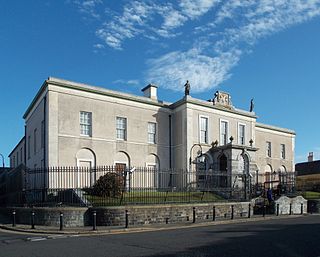
Downpatrick is a town in County Down, Northern Ireland. It is on the Lecale peninsula, about 21 mi (34 km) south of Belfast. In the Middle Ages, it was the capital of the Dál Fiatach, the main ruling dynasty of Ulaid. Its cathedral is said to be the burial place of Saint Patrick. Today, it is the county town of Down and the joint headquarters of Newry, Mourne and Down District Council. Downpatrick had a population of 11,545 according to the 2021 Census.

Newry Town Hall is a municipal structure in Bank Parade in Newry, Northern Ireland. It was built on a specially-constructed bridge across the Newry River, which forms part of the historic border between County Armagh and County Down. The town hall, which was the headquarters of Newry Urban District Council, is a Grade B1 listed building.

Thomas John Duff (1792–1848) was an Irish architect from Newry, County Down. Duff was the principal architect of a number of Roman Catholic churches and cathedrals in the northeast of Ireland.

Market House is a municipal building in Conway Square, Newtownards, County Down, Northern Ireland. It is a Grade B+ listed building.

Downpatrick Courthouse is a judicial facility on English Street, Downpatrick, County Down, Northern Ireland. The courthouse, which served as the headquarters of Down County Council from 1878 to 1973, is a Grade B+ listed building.

The Old Council House is a former municipal building in Poplar Road, Solihull, West Midlands, England. The town hall, which was the meeting place of Solihull Borough Council, is now a public house.

Ballymena Town Hall is a municipal structure in Bridge Street in Ballymena, County Antrim, Northern Ireland. The town hall, which is the headquarters of Mid and East Antrim Borough Council, is a Grade B1 listed building.

Larne Town Hall is a municipal structure in Upper Cross Street in Larne, County Antrim, Northern Ireland. The structure, which was the meeting place of Larne Borough Council, is a Grade B+ listed building.

The Old Town Hall is a municipal structure in Scarva Street in Banbridge, County Down, Northern Ireland. The structure, which currently accommodates a Community Advice Centre on the ground floor and a room for local community groups on the first floor, is a Grade B1 listed building.

The Roe Valley Arts & Cultural Centre, formerly the Alexander Memorial Hall and originally Limavady Town Hall, is a civic venue in Main Street in Limavady, County Londonderry, Northern Ireland. The structure, which incorporates the façade of the old town hall, was previously a Grade B1 listed building but was delisted in July 1998 to facilitate the demolition of the structure behind the façade and the subsequent erection of a new cultural centre.

Ballymoney Town Hall is a municipal structure in the High Street, Ballymoney, County Antrim, Northern Ireland. The structure, which incorporates a local history museum, is a Grade B1 listed building.

Lurgan Town Hall is a municipal structure in Union Street, Lurgan, County Armagh, Northern Ireland. The structure, which is primarily used as a community, arts and resource centre, is a Grade B1 listed building.

Portadown Town Hall is a municipal structure in Edward Street, Portadown, County Armagh, Northern Ireland. The structure, which is primarily used as a theatre, is a Grade B1 listed building.

Wirksworth Town Hall is a municipal building in Coldwell Street, Wirksworth, Derbyshire, England. The town hall, which was the headquarters of Wirksworth Urban District Council, now accommodates the local public library.

Sheringham Town Hall, formerly known as Sheringham Council Offices, is a former municipal building in Church Street, Sheringham, Norfolk, England. The structure served as the headquarters of Sheringham Urban District Council and then as the offices and meeting place of Sheringham Town Council until it closed in August 2019.

The Old Town Hall is a municipal structure in Castle Street, Lisburn, County Antrim, Northern Ireland. The structure, which is used as a constituency office by the Democratic Unionist Party, is a Grade B2 listed building.

Portrush Town Hall is a municipal structure in Mark Street, Portrush, County Antrim, Northern Ireland. The structure, which is used as an events venue, is a Grade B+ listed building.

Portstewart Town Hall is a municipal structure in The Crescent, Portstewart, County Londonderry, Northern Ireland. The structure, which has been closed to the public since December 2019, is a Grade B2 listed building.

Dromore Town Hall is a municipal structure in the centre of Dromore, County Down. The structure, which is now used as a public library, is a Grade B1 listed building.

Donaghadee Town Hall, also known as The Merchant House, is a municipal structure in the High Street, Donaghadee, County Down, Northern Ireland. The structure, which has been converted for residential use, is a Grade B+ listed building.






















